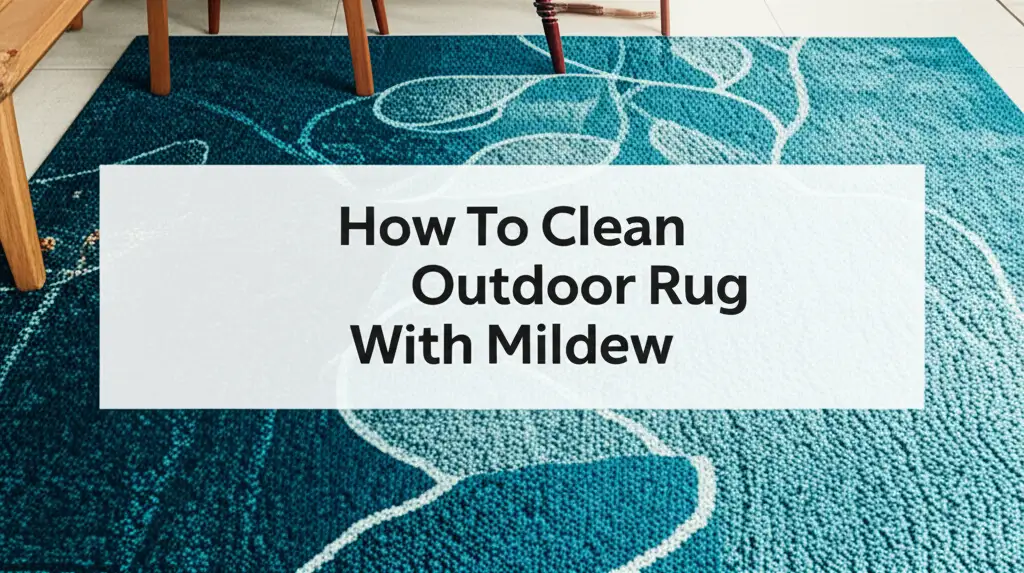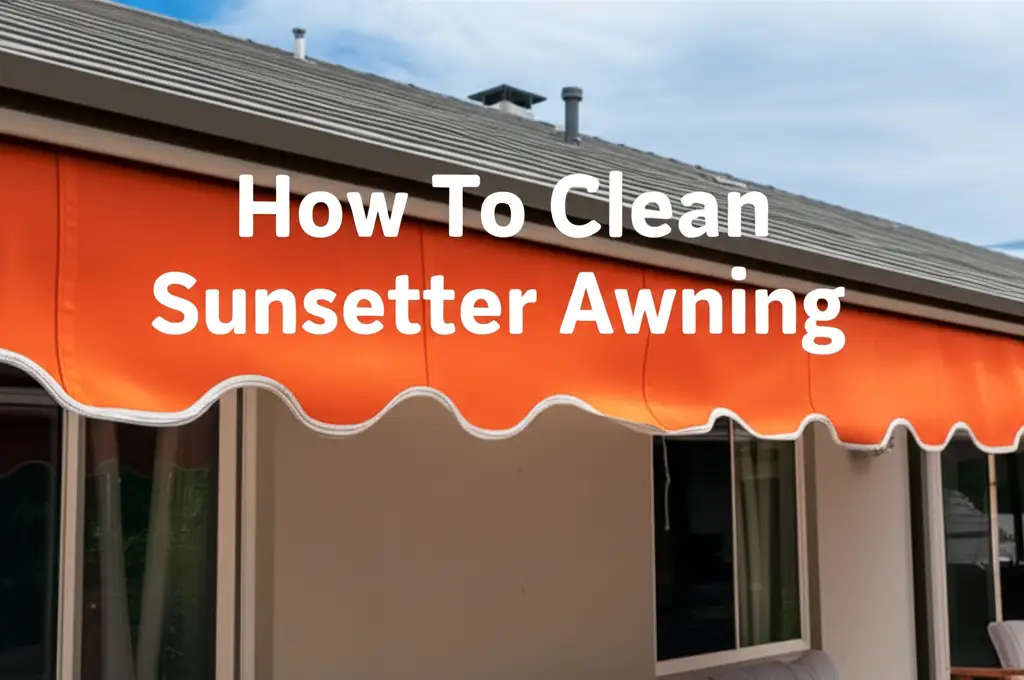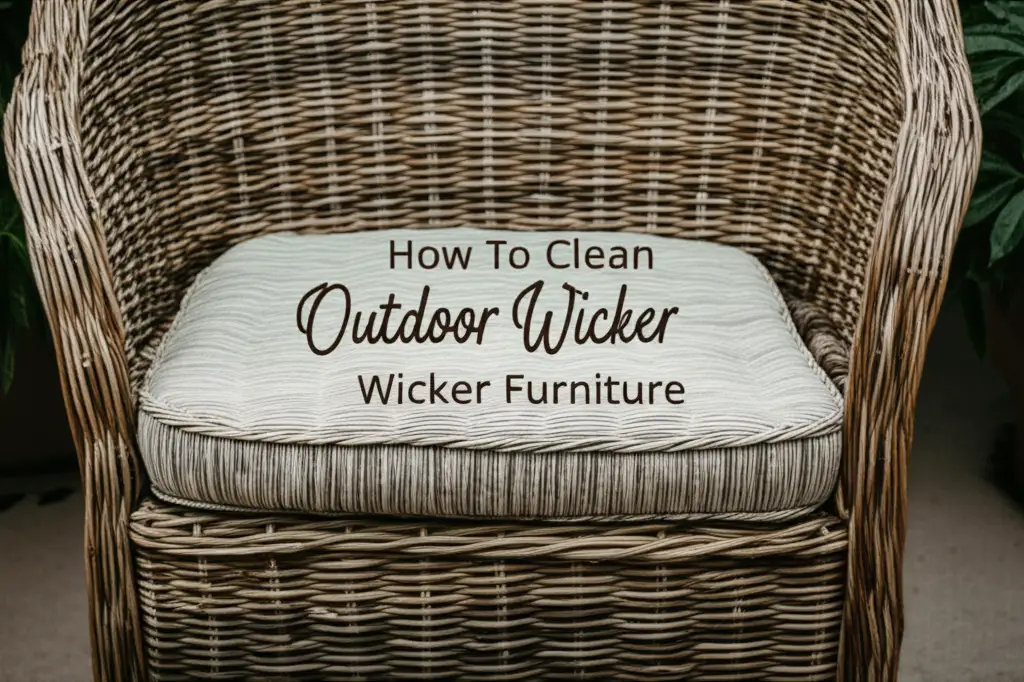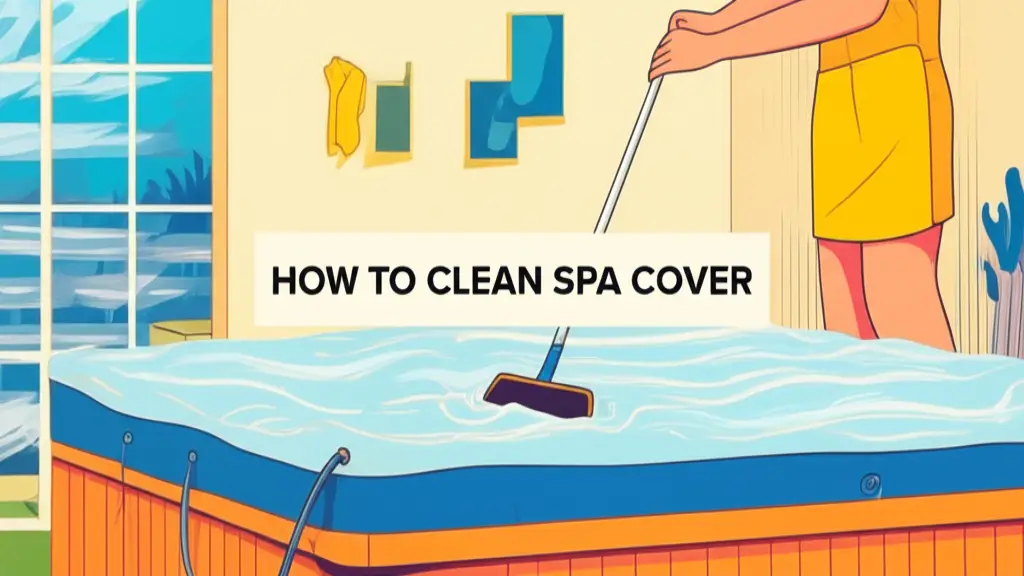· Outdoor Cleaning · 12 min read
How To Clean Outdoor Rug With Mildew

Revive Your Patio: How to Clean Outdoor Rug with Mildew
An outdoor rug makes your patio cozy. It adds style and comfort. But outdoor environments are humid. They often cause problems like mildew. Mildew looks bad. It also smells bad. It can damage your rug over time. Knowing how to clean an outdoor rug with mildew is important. This guide will show you easy steps to remove mildew. We will discuss various cleaning solutions. You will learn about safe handling. We will also cover prevention tips. This helps keep your rug fresh. You can enjoy your outdoor space without worry.
Takeaway:
- Identify mildew early to prevent spread.
- Choose the right cleaning solution for your rug material.
- Always test cleaning solutions on a small, hidden area first.
- Ensure the rug dries completely after cleaning to stop mildew regrowth.
- Implement regular maintenance and proper storage to prevent future mildew.
To clean an outdoor rug with mildew, first remove loose debris. Then, apply a cleaning solution like white vinegar, baking soda paste, or a diluted bleach mixture. Scrub the affected areas gently. Rinse the rug thoroughly with water. Ensure it dries completely in a sunny, well-ventilated spot before you use or store it.
Understanding Mildew on Outdoor Rugs
Mildew is a type of fungus. It grows in damp places. Outdoor rugs are prone to mildew growth. This is due to moisture. Rain, humidity, and spills create ideal conditions. Mildew appears as a powdery, fuzzy patch. It can be white, gray, or black. It smells musty. If left untreated, mildew can spread. It can weaken rug fibers. It may also cause discoloration. Identifying mildew early saves your rug. It also protects your outdoor space.
I often see outdoor rugs covered in mildew. It forms quickly after a few rainy days. The mold spores thrive on the rug’s surface. They feed on organic matter. This includes dirt or dead leaves. The rug’s material also matters. Some materials hold moisture more than others. Synthetic rugs are usually more resistant. Natural fiber rugs are more susceptible. Always check your rug for mildew signs. Look on both sides. The underside often has more growth. This is because it stays damp longer. You need to act fast when you spot it. This stops the spread.
Essential Tools and Safety Precautions
Before you start cleaning, gather your tools. You will need a stiff brush. A bucket for mixing solutions is also useful. A garden hose provides water for rinsing. You will also need your chosen cleaning agent. Safety is important during cleaning. Wear gloves to protect your hands. Safety goggles shield your eyes. This prevents splashes from reaching them. Work in a well-ventilated area. This avoids inhaling fumes. Especially when using bleach.
I always put on my gloves first. Then I grab my trusty scrub brush. I make sure to have plenty of water ready. Mixing solutions outdoors is best. This ensures good airflow. Never mix bleach with other cleaners. This creates dangerous gases. Keep pets and children away from the cleaning area. They should not touch the cleaning solutions. After cleaning, wash your hands thoroughly. Clean all tools before storing them. This removes any chemical residue. Protecting yourself keeps the cleaning process safe.
Pre-Cleaning Steps for Your Mildewed Rug
Proper preparation helps the cleaning process. First, remove the rug from your patio. Place it on a hard, clean surface. A concrete driveway works well. This allows easy access. It also keeps your patio clean. Shake the rug vigorously. This removes loose dirt. It also dislodges debris. Use a stiff brush or broom. Brush off any larger pieces of mildew. This also removes dirt and leaves. This step helps the cleaning solution work better. It focuses on the mildew itself.
I always start by giving the rug a good shake. It is surprising how much dirt comes out. Then, I take my broom and sweep off any stubborn bits. Sometimes, there are dried leaves stuck in the fibers. Getting these off makes a big difference. It means I am not scrubbing dirt deeper into the rug. This pre-cleaning sets the stage for a successful mildew removal. It makes the next steps more effective. A clean starting point means better results.
Natural Cleaning Solutions for Mildew Removal
You can use natural options to remove mildew. These are safer for the environment. They are also gentle on many rug materials. White vinegar is a good choice. It is acidic. It kills mold and mildew. Mix equal parts white vinegar and water. You can also use baking soda. Baking soda absorbs odors. It also has mild abrasive properties. It helps scrub away mildew. You can combine these for a stronger effect.
White Vinegar Method
- Prepare the Solution: Mix white vinegar and water. Use a 1:1 ratio. For example, use one cup of vinegar and one cup of water. Put this mixture into a spray bottle.
- Apply to Mildew: Spray the vinegar solution directly onto the mildewed areas. Make sure the spots are fully wet.
- Let it Sit: Let the solution sit on the rug for about 30 minutes. The vinegar needs time to kill the mildew spores.
- Scrub the Rug: Use a stiff brush to scrub the mildewed spots. Work the bristles into the rug fibers. You will see the mildew lift away.
- Rinse Thoroughly: Rinse the entire rug with a garden hose. Make sure all vinegar residue is gone.
- Dry Completely: Hang the rug to dry. Ensure it dries fully. Sunlight helps kill remaining spores.
I have used vinegar on my outdoor rug many times. It works well. The vinegar smell goes away as the rug dries. I find it very effective for light mildew. It is a good first approach.
Baking Soda Paste Method
- Create Paste: Mix baking soda with a small amount of water. Add water slowly. You want a thick paste.
- Apply to Mildew: Spread the paste over the mildew spots. Cover them completely.
- Let it Sit: Allow the paste to dry on the rug. This may take a few hours. The baking soda will absorb odors. It also helps break down the mildew.
- Scrub and Rinse: Once dry, scrub the paste with a stiff brush. This removes the mildew. Rinse the rug well with water.
- Dry Completely: Dry the rug completely in the sun. This ensures no moisture remains.
Baking soda is good for odors. It also helps with the mildew itself. I use it for tougher spots. Combining it with vinegar can give extra power. You can learn more about general cleaning with these natural ingredients here: How To Clean With Vinegar And Baking Soda.
Stronger Solutions for Stubborn Mildew
Sometimes, natural methods are not enough. For severe mildew, you may need stronger cleaners. Bleach is a powerful disinfectant. It kills mildew effectively. However, it can damage some rug materials. It can also bleach colors. Always test bleach on an inconspicuous area first. This checks for colorfastness. Hydrogen peroxide is another option. It is less harsh than bleach. It also works as an oxidizer.
Bleach Solution Method
- Dilute Bleach: Mix one cup of bleach with one gallon of water. Use a large bucket for this.
- Test First: Apply a small amount to a hidden spot on your rug. Wait 15 minutes. Check for discoloration. If the color holds, proceed.
- Apply Solution: Apply the diluted bleach solution to the mildewed areas. You can use a spray bottle or a sponge.
- Let it Sit: Let the solution sit for 10-15 minutes. Do not let it dry on the rug.
- Scrub Gently: Scrub the areas with a stiff brush. The mildew should start to disappear.
- Rinse Thoroughly: Rinse the entire rug very well with a hose. Ensure all bleach is gone. Residual bleach can damage fibers.
- Dry Completely: Dry the rug fully in direct sunlight. This helps air it out.
Bleach is strong. It works wonders on tough mildew. But I am always careful with it. I only use it when other methods fail. For similar outdoor items, the same principles apply: How To Clean Mildew Off Outdoor Cushions.
Oxygen Bleach or Hydrogen Peroxide Method
Oxygen bleach is a gentler alternative. It is usually safe for colors. Hydrogen peroxide is also less harsh than chlorine bleach.
- Mix Solution: Follow product instructions for oxygen bleach. For hydrogen peroxide, mix 1 part 3% hydrogen peroxide with 2 parts water.
- Apply and Sit: Apply the solution to the mildew. Let it sit for 20-30 minutes.
- Scrub and Rinse: Scrub the affected areas. Rinse the rug thoroughly with water.
- Dry: Ensure the rug dries completely.
I prefer oxygen bleach when I need something stronger than vinegar but less harsh than chlorine bleach. It is usually effective for most persistent mildew stains.
Drying Your Outdoor Rug Completely
Drying the rug properly is critical. Incomplete drying leads to mildew regrowth. After rinsing, remove as much water as possible. You can use a squeegee. Or roll the rug tightly to squeeze water out. Hang the rug in a sunny spot. A clothesline or railing works well. Elevate it. This allows air to circulate on both sides. If possible, flip the rug periodically. This ensures even drying. Drying can take 24-48 hours. This depends on weather. Do not put the rug back until it is bone dry.
I always aim for a sunny, breezy day to clean my rugs. This speeds up drying time. I hang it over a fence or chairs. This lifts it off the ground. I check both sides. Sometimes the underside takes longer to dry. If the weather changes, I bring it inside. I can finish drying it indoors with fans. Complete drying is the most important step. It prevents mildew from coming back.
Preventing Future Mildew Growth
Prevention is easier than cleaning. Keep your outdoor rug dry. This is the best defense against mildew.
- Rotate and Elevate: Move your rug periodically. Lift it off the ground. This allows the patio surface to dry. It also exposes the rug’s underside to air.
- Dry After Rain: After rain, hang the rug to dry. Do not let it sit wet for long.
- Clean Spills Promptly: Clean up food and drink spills quickly. These provide nutrients for mildew.
- Store Properly: Store your rug during long periods of wet weather. Roll it up. Store it in a dry, well-ventilated area. A storage box is good. Make sure it is completely dry before storing.
- Regular Cleaning: Give your rug a light cleaning often. Sweep it. Hose it down. This prevents dirt buildup. It also removes mildew before it takes hold.
- Use a Rug Pad: Some rug pads can help with drainage. They lift the rug slightly. This allows air circulation underneath.
- Consider Anti-Mildew Sprays: You can use fabric protection sprays. Some have mildew inhibitors. Apply these after cleaning. Always test first.
I have found that lifting my rug every few days really helps. Just a quick lift and flip lets air get under it. This prevents that damp, musty smell. It also stops mildew before it starts. Regular small actions save a lot of work later. Keeping the rug dry is the main goal. It keeps your outdoor rug looking great.
When to Consider Professional Cleaning or Replacement
Sometimes, a rug is beyond home cleaning. Very old or severe mildew can be difficult. If mildew covers most of the rug, consider professional cleaning. Professionals have stronger equipment. They use specialized solutions. They can often restore heavily affected rugs. However, some damage is permanent. If the rug fibers are weak, replacement is better. Discoloration may not come out. A strong, persistent musty smell means mildew is deep in the fibers. This can be hard to remove.
I faced this with an old rug. It had been left wet for too long. The mildew was extensive. Even after multiple attempts, the smell lingered. The fibers felt brittle. At that point, it was clear. A new rug was the best option. It is hard to let go of a favorite rug. But a clean, fresh space is important. Sometimes, replacing it saves time and effort. This also ensures a healthy environment.
FAQ Section
Q1: Can I use a pressure washer to clean my outdoor rug?
A pressure washer can clean outdoor rugs. Use a low-pressure setting. Hold the nozzle far from the rug. High pressure can damage fibers. It can also fray edges. Test a small area first. This ensures the rug can withstand the pressure. Pressure washing helps remove tough grime quickly.
Q2: How often should I clean my outdoor rug to prevent mildew?
Clean your outdoor rug regularly. Sweep or vacuum it weekly. Hose it down monthly. Do a deep clean every few months. After heavy rain, dry the rug immediately. This regular care prevents mildew from taking hold. Adjust frequency based on your climate. Humid areas need more attention.
Q3: Is mold the same as mildew?
Mold and mildew are both fungi. They grow in damp places. Mildew is typically flat and powdery. It is often white, gray, or yellow. Mold can be fuzzy. It often has a deeper color like black or green. Mold can also penetrate surfaces. Mildew usually stays on the surface. Both need moisture to grow.
Q4: Will cleaning an outdoor rug with mildew damage its color?
Some cleaning solutions can affect rug color. Bleach is the main concern. It can cause fading. Always test solutions on a hidden spot first. Oxygen bleach is gentler on colors. White vinegar is generally safe. Rinse the rug thoroughly. This removes any cleaning solution residue.
Q5: What is the best way to store an outdoor rug?
Store your outdoor rug dry and clean. Roll it up tightly. Place it in a breathable bag or container. Avoid plastic bags. They trap moisture. Store it in a cool, dry place. A garage or shed works. Ensure the rug is completely dry before storage. This prevents mildew growth while stored.
Q6: Can I put my outdoor rug in the washing machine?
Check your rug’s care tag. Some smaller outdoor rugs are machine washable. Use a gentle cycle with cold water. Use a mild detergent. Do not machine wash large or natural fiber rugs. They can get damaged. Always air dry machine-washed rugs. Avoid machine drying.
Conclusion
Cleaning an outdoor rug with mildew is manageable. You have effective solutions. Start with simple methods like vinegar or baking soda. Move to stronger options if needed. Always prioritize safety. Protect yourself during the cleaning process. Proper drying is crucial. It stops mildew from returning. By taking these steps, your outdoor rug will look new. It will enhance your outdoor space. Regular maintenance also keeps mildew away. This means you can enjoy your patio. You will have a fresh, clean rug for many seasons. Keep your outdoor rug dry. This is the best defense against mildew growth.
- outdoor rug cleaning
- mildew removal
- patio rug care
- mold on rug




